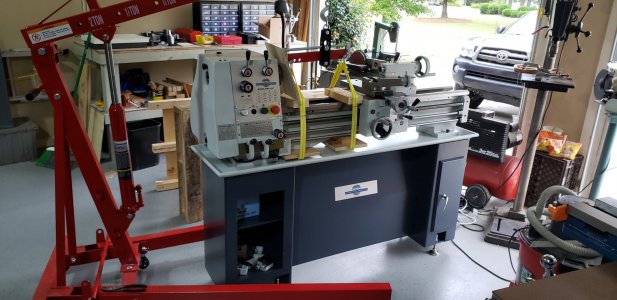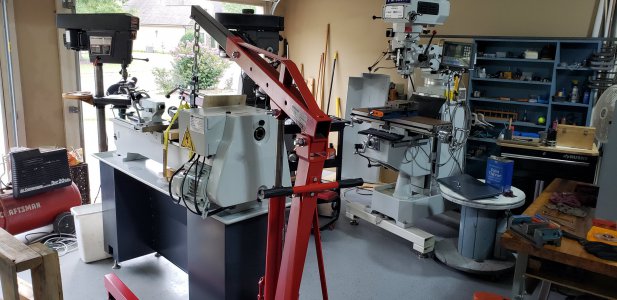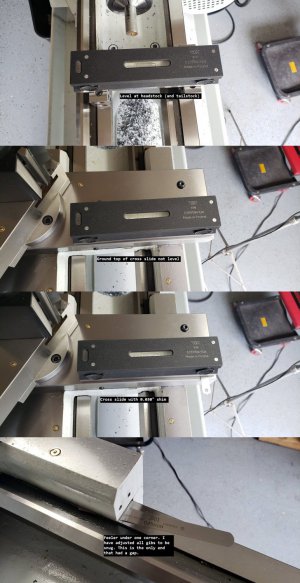I got the lathe onto the stand. I did it alone with no problems. I used two pointed wood dowels to help guide it to the holes (a hint from P.M. tech support). I did a cursory leveling and am doing pre-startup checks. Once I get it bolted down and running I'll do the final leveling.
-
Welcome back Guest! Did you know you can mentor other members here at H-M? If not, please check out our Relaunch of Hobby Machinist Mentoring Program!
You are using an out of date browser. It may not display this or other websites correctly.
You should upgrade or use an alternative browser.
You should upgrade or use an alternative browser.
New PM-1236T Lathe has arrived
- Thread starter riveter
- Start date
where did you get your leveling casters and what size do ya order? Getting ready to set up 1340 this weekend and not too about using those orange casters that came with the base or go ahead and grab something else from McMaster, etc.. Really only want to have to do this once
It looks like you used the same ones that are in the drawing for your mill base. The 6111K246 from McMaster I think. Did they fit up pretty well for you in the existing holes and get it leveled fairly painless?
Big Problem?
I have been inspecting everything I can on this lathe so if there is a problem, I can notify P.M. and get it taken care of. I have leveled it and made some cuts with it. The manual says this:
I then placed the level on the cross slide. I expected it to be coplaner to the ways, but the level showed the cross slide to be tilted away from the operator side. It takes a 0.030 inch shim to get the level to indicate level.
I'm not an expert, but I think this is a problem. At the least, the tool will get lower as I feed across the ways. And I do carefully set the tool holder so the tool is aligned in Z to the spindle center line. Indicating the cross slide with reference to the bed ways shows the tool holder is traveling downhill. I flipped the straightedge end for end and got the same result. The tool drops 0.015 inch over about 7 inches travel.
Can anyone confirm that their cross slide is level when the bed is level?
I have been inspecting everything I can on this lathe so if there is a problem, I can notify P.M. and get it taken care of. I have leveled it and made some cuts with it. The manual says this:
I used machinist level and a pair of 123 blocks which I verified with my 2 inch micrometer. These were placed on the flat ways and the bed was leveled near the headstock and near the tailstock. All 6 feet were adjusted so they are carrying weight.Check and adjust level front-to-back across the bed using a matched pair of spacer blocks to clear the Vee tenons on the bed ways. The blocks need to be ground, or otherwise accurately dimensioned. Alternatively, check for level on the ground surface of the cross slide as the carriage is traversed from end to end.
I then placed the level on the cross slide. I expected it to be coplaner to the ways, but the level showed the cross slide to be tilted away from the operator side. It takes a 0.030 inch shim to get the level to indicate level.
I'm not an expert, but I think this is a problem. At the least, the tool will get lower as I feed across the ways. And I do carefully set the tool holder so the tool is aligned in Z to the spindle center line. Indicating the cross slide with reference to the bed ways shows the tool holder is traveling downhill. I flipped the straightedge end for end and got the same result. The tool drops 0.015 inch over about 7 inches travel.
Can anyone confirm that their cross slide is level when the bed is level?
Attachments
Last edited:
I did the flat ways method first and used the leveling feet to remove the twist from the bed. Then I cross checked with the level on top of the cross slide and discovered the surface is not coplaner to the bed ways.I would use the 1-2-3 blocks on the flat ways and measure at the head stock and then the tailstock to see if you have any bed twist. Adjust accordingly to take out any twist.
- Joined
- Jun 12, 2014
- Messages
- 4,817
The carriage is at a different level then the flat surfaces of the ways, they are almost always not at the same level, and for that matter it makes no difference as long as there is no bed twist (i.e. the bubble is in the same position from one end to the other). I prefer to use 123 blocks on the flats of the ways to measure for bed twist. others prefer the carriage. Use on OR the other.
- Joined
- Feb 22, 2015
- Messages
- 107
I checked mine (PM1127) and found that the foot stock flat and the carriage flat are not in the same plane. Crap mines out too. Then I thought about it. It doesn't matter as long as the bed is not twisted. If the motion of the cross slide is in a straight line, it will not matter what angle the radial line from the center of rotation the tool follows relative to the plane created by the foot stock flat and the carriage flat, as long as the endpoint is at the center of rotation of the work. Congratulations on your new machine 
It is probably alright for most lathe work. But I have a milling vise that I want to use on the lathe as a backup milling option. I can't do accurate milling with a vise that runs downhill with respect to the spindle. I have reached out to P.M. for a solution. They are contacting the factory.




